Authentic Gaisburger Marsch
This post may contain affiliate links. See my disclosure policy.
The famous stew from my home of Stuttgart, Germany, Gaisburger Marsch is a traditional stew that captures the very best of Swabian cuisine. Tender beef, homemade Spätzle, and potatoes in a luxuriously rich broth and topped with onions caramelized in butter. It just doesn’t get any better!

Growing up in Stuttgart, Germany, I have a special affinity for Swabian cuisine. Born in Bavaria and later raised in Stuttgart, my mother enjoyed a cooking education from Germany’s best food regions. She is a marvelous cook and regularly made us dishes from all around the world. But her Swabian cooking in particular has always given me sense of comforting “groundedness” and reminds me of home.
My mom’s Gaisburger Marsch was always one of our favorite stews. Watching her ladle bowlfuls of it from the soup tureen we eagerly awaited that first mouthful, always making sure to get some of those glorious caramelized onions on the spoon. Gaisburger Marsch is one of those traditional Swabian dishes that are known in every Swabian household and while it occasionally appears on restaurant menus in Swabia, it’s definitely not “tourist fare.” I like to think of it as one of our “insider” secrets.

What is Gaisburger Marsch?
Gaisburger Marsch is a traditional Swabian stew featuring beef cooked in a rich broth with potatoes, Spätzle, and topped with caramelized onions. The dish is named after Gaisburg, a suburb of my hometown of Stuttgart in Baden-Württemberg, Germany. The settlement of Gaisburg was established sometime in the 11th or 12 century and the community remained independent until being incorporated into Stuttgart in 1901.
This dish is believed to have originated some time in the 19th century as a way to use up leftovers. Marsch is German for “march” and there several legends surrounding its origin. One is that the stew was so popular among 19th century soldiers that they would march all the way from their barracks to a restaurant in Gaisburg, the Bäckerschmide, just to enjoy a serving of it. The other story goes that when the soldiers from Gaisburg became prisoners of war and provisions were sorely lacking, their wives created this hearty and nourishing stew and that they would march into camp to bring to their men.
The September 25, 1933 edition of the newspaper, the Stuttgarter Neues Tagblatt, later confirmed this sentiment when it wrote,”For us Stuttgarters we only need to remember the famous and justifiably popular ‘Gaisburger March’…a stew that, if it is well prepared and well seasoned, feeds its man very well.” Include women in that and I couldn’t agree more!

Gaisburger Marsch is definitely a labor of love. Especially if you are making everything from scratch which, for the best flavor results, is what I recommend. Everything from roasting the beef marrow bones for the homemade broth to making your own Spätzle. To enjoy Swabian cuisine at its best, you don’t cut corners! That said, I provide an alternative to the most time-consuming aspect of this recipe and that is to substitute beef broth for the roasted beef bones and water – but don’t omit anything else!
Celeriac and leek are both a must to achieving an authentic German flavor. In Germany, the combination of celeriac, leek, carrots and parsley are staple ingredients in almost any clear broth base. So much so that you can get these in the produce section of grocery stores already tied together in grab-and-go-bundles called Suppengrün (“soup greens”).
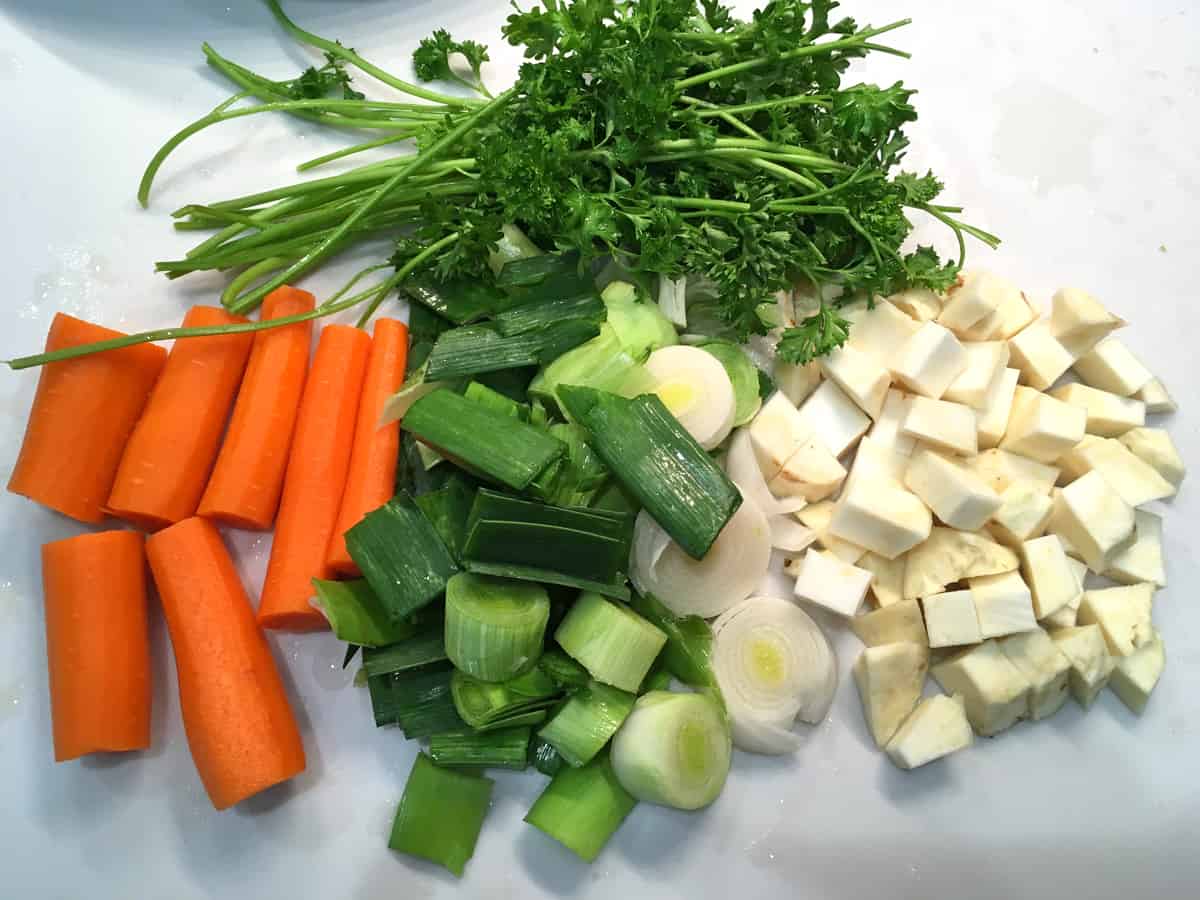
Choose quality ingredients (including the beef broth if you’re choosing to skip the beef marrow bones), don’t omit any of the ingredients, and your efforts will be rewarded.
The end result will be a very authentic Gaisburger Marsch that is incredibly delicious and thoroughly satisfying!

Gaisburger Marsch Recipe
Let’s get started!
If you prefer to skip this step, omit the bones and use a good beef broth in place of the water and proceed with the instructions as written.
Preheat the oven to 450 degrees F. Lay the beef marrow bones on a lined baking sheet. Roast the bones for 25-30 minutes or until they’re nicely browned.
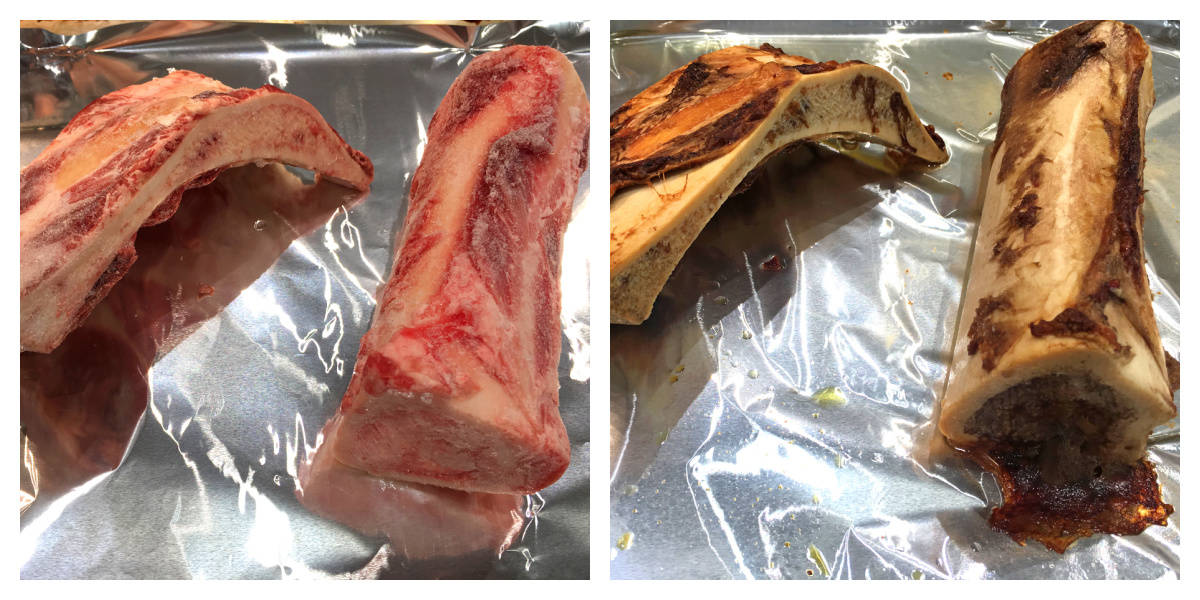
Rough chop the celeriac, leek, carrots, and onions and leave the parsley sprigs whole.
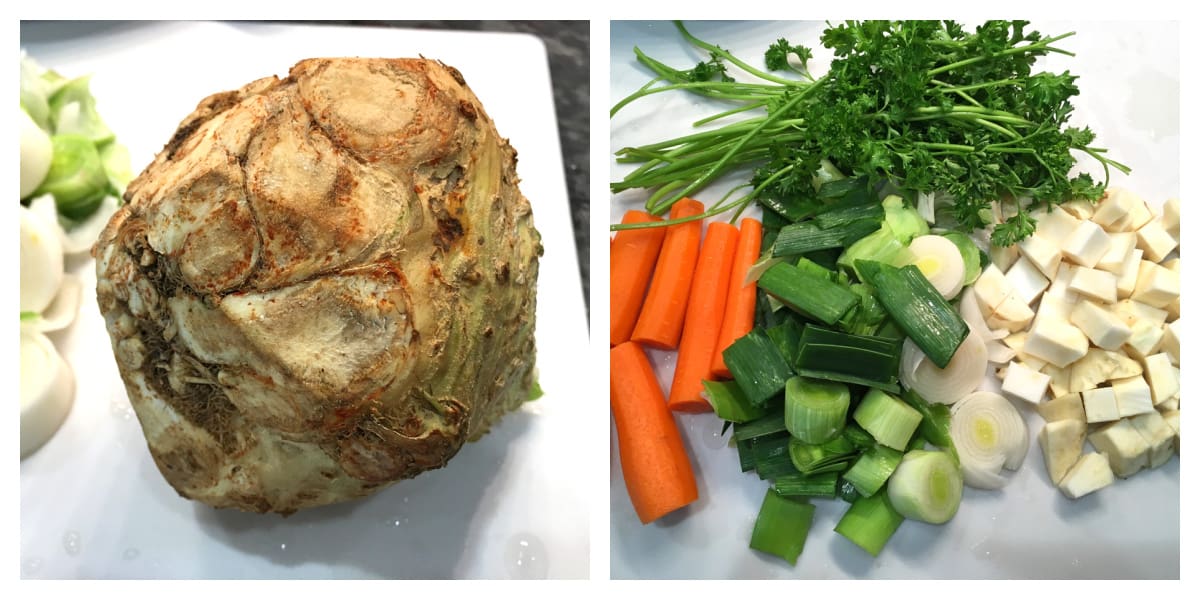
Place the roasted bones in 10 cups of water in a heavy stock pot (if omitting the bones use 10 cups of quality beef broth).
NOTE: If you’re using beef short ribs instead of diced stewing beef you’ll add them now (see Note in recipe box below for detailed instructions) .
Add the vegetables and parsley along with the bay leaves, peppercorns, garlic, and dried herbs. Bring to a boil, reduce the heat to low, cover and simmer for 2 hours. Skim off any brown foam that forms. (If you’re not using the bones and are using beef broth instead, reduce the heat to medium instead of low and simmer for 40 minutes).
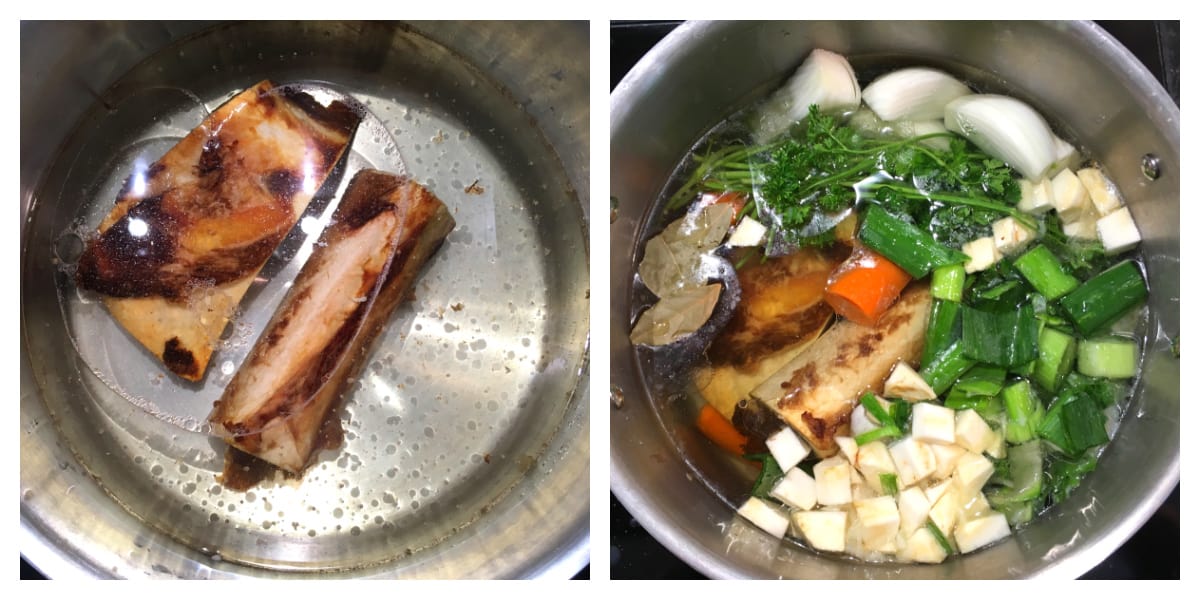
While the broth is simmering prepare the caramelized onions.
Melt the butter in a pan over medium high heat and cook the onions until soft and translucent. Add a small pinch of salt and a small pinch of sugar and continue to cook the onions, stirring every few minutes, for at least another 30 minutes until nicely browned. As the onions turn more brown and begin sticking to the pan, reduce the heat to medium. Add a little more butter if needed. Set aside until ready to use.
Note: You can make these in advance and keep them covered in a bowl in the refrigerator for up to a week.
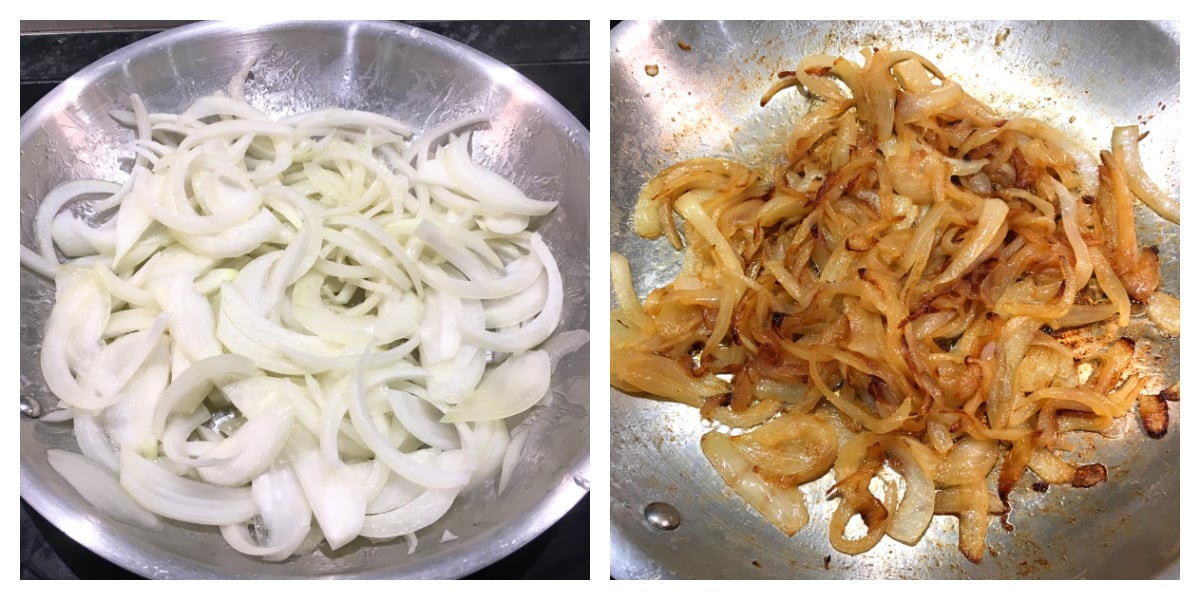
Once the broth is done, pour it into a large bowl through a fine mesh strainer.
Clean out the pot and return the strained broth to the pot.
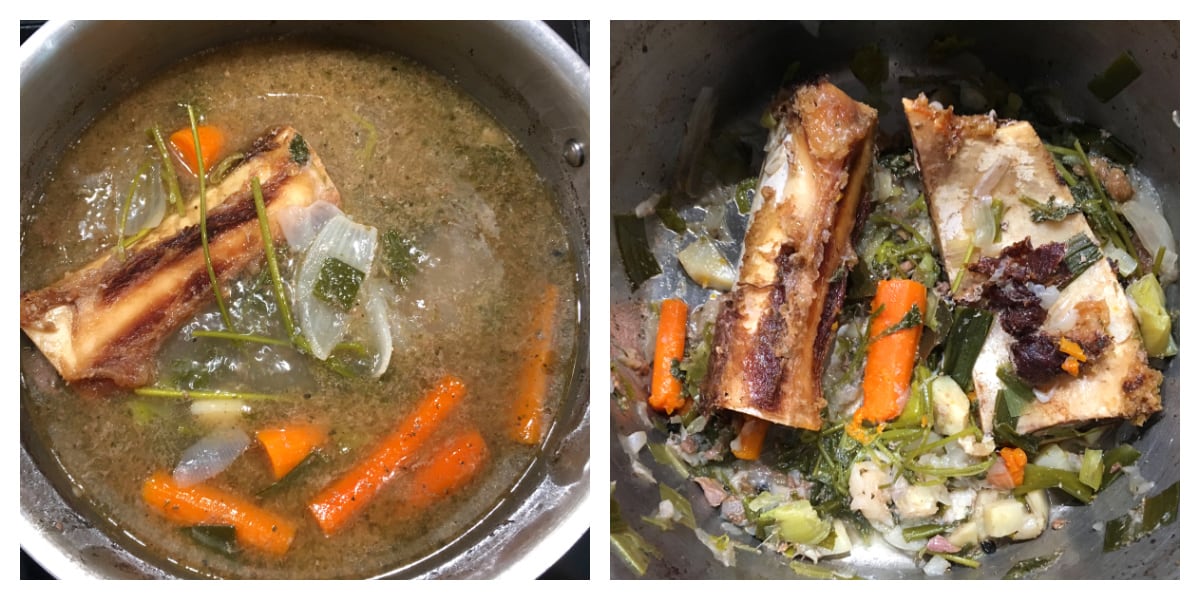
Add the beef, potatoes, salt and pepper to the broth, bring to a boil, reduce the heat to medium, cover and simmer for about 30 minutes or until the beef is tender.
Add the cooked Spätzle and parsley and heat through. Add salt and pepper to taste. (You can either make our homemade Spaetzle or use store-bought.)
This soup makes great leftovers and tastes even better the next day.
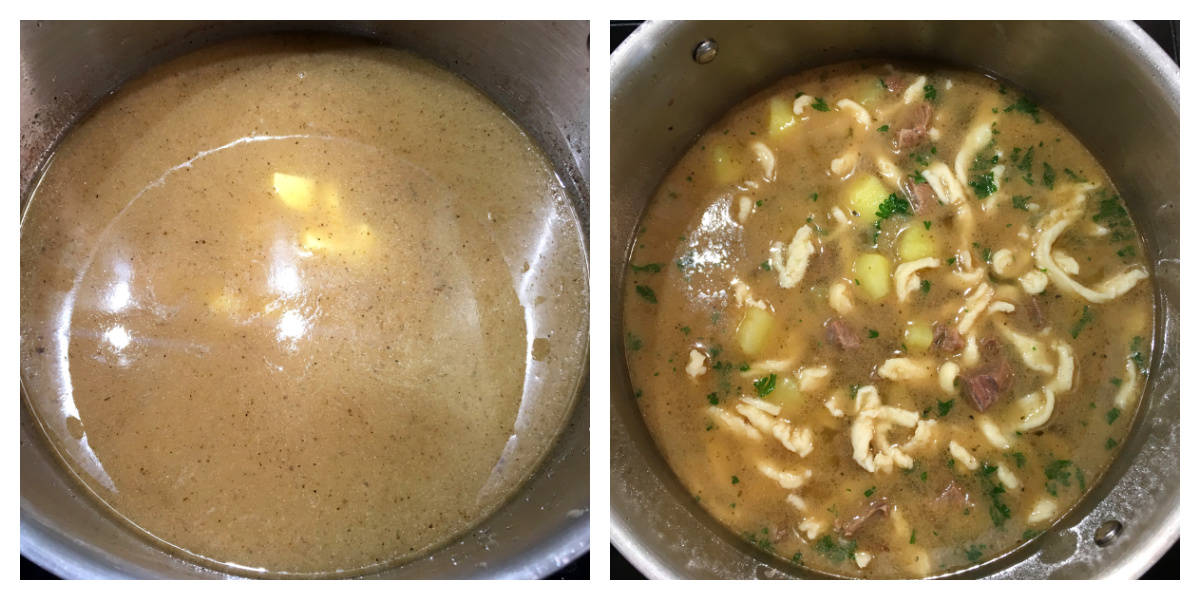
Ladle the Gaisburger Marsch into bowls and top with some of the caramelized onions. Garnish with some chopped parsley.
Enjoy!

For more delicious authentic German recipes be sure to try my:
- Rouladen
- Sauerbraten
- Schnitzel
- Jägerschnitzel
- German Goulash
- Maultaschen
- Frikadellen
- Spätzle
- Käsespätzle
- Currywurst
- German Potato Soup
- Sauerkraut Soup
- Kartoffelpuffer
- German Potato Dumplings
- Flädlesuppe
- German Bread (Vollkornbrot)
Save This Recipe

Authentic Gaisburger Marsch
Ingredients
- 2-3 beef marrow bones (optional, see instructions below for using beef broth instead)
- 10 cups water (**or beef broth) (**if omitting the bones use 8-9 cups quality beef broth instead. You're using less broth than water because about 2 cups of the water will evaporate from the long simmer time.)
- 1 large leek , roughly chopped and thoroughly washed and drained (leek collects a lot of dirt inside of its leaves)
- 1/2 small celeriac , roughly chopped (outer skin peeled/discarded)
- 2 large carrots , roughly chopped
- 1 large yellow onion , roughly chopped
- 1/2 bunch fresh parsley , clean and leave the sprigs whole
- 3 cloves garlic , cut in half
- 1 teaspoon whole black peppercorns
- 3 bay leaves
- 1/2 teaspoon dried thyme
- 1/2 teaspoon dried marjoram
- 1 1/2 teaspoons salt
- 1/4 teaspoon freshly ground black pepper
- 1 1/4 pounds stewing beef , diced (OR 1 3/4 pounds beef short ribs or beef shank. See NOTE below for instructions.)
- 2 pounds firm, waxy potatoes (e.g., Yukon Gold), diced
- 4 cups homemade Spätzle
- or 4 cups cooked store-bought Spätzle (cooked according to package instructions)
- 3 tablespoons chopped parsley plus extra for garnish
- For the Caramelized Onions:
- 3 tablespoons unsalted butter
- 2 large yellow onions , halved and cut into thin strips
- a pinch of salt and sugar
Instructions
- Roast the Bones (if you are omitting the bones skip to the next step): Preheat the oven to 450 degrees F. Lay the beef marrow bones on a lined baking sheet. Roast the bones for 25-30 minutes or until they're nicely browned.
- Make the Broth: Place the roasted bones in 10 cups of water in a heavy stock pot (if omitting the bones use 10 cups of beef broth). Add the vegetables and parsley along with the bay leaves, peppercorns, garlic, and dried herbs. Bring to a boil, reduce the heat to low, cover and simmer for 2 hours. Skim off any brown foam that forms. (If you're not using the bones and are using beef broth instead, reduce the heat to medium instead of low and simmer for 40 minutes).
- Caramelize the Onions: While the broth is simmering, melt the butter in a pan over medium high heat and cook the onions until soft and translucent. Add a small pinch of salt and a small pinch of sugar and continue to cook the onions, stirring every few minutes, for at least another 30 minutes until nicely browned. As the onions turn more brown and begin sticking to the pan, reduce the heat to medium. Add a little more butter if needed. Set aside until ready to use. Note: You can make these in advance and keep them covered in a bowl in the refrigerator for up to a week.
- Once the broth is done, pour it into a large bowl through a fine mesh strainer. Clean out the pot and return the strained broth to the pot. Add the beef, potatoes, salt and pepper to the broth, bring to a boil, reduce the heat to medium, cover and simmer for about 30 minutes or until the beef is tender.Add the Spaetzle and parsley and heat through. Add salt and pepper to taste. Ladle the Gaisburger Marsch into bowls and top with some of the caramelized onions. Garnish with some chopped parsley. This soup makes great leftovers and tastes even better the next day.
Notes
Originally published on The Daring Gourmet February 13, 2022



















I was delighted to find this recipe of Gaisburger Marsch! This morning, when talking about food and recipes, I told my son about Gaisburger Marsch. To my chagrin, I did not find the recipe in any of my old German cookbooks — not even in the one from Stuttgart. I was born and grew up in Stuttgart-Bad Cannstatt, and my mother always made Gaisburger Marsch on Saturdays! We alternatively used to call it Kartoffelschnitz ond Spätzle! She even made it once when my son and I visited — long ago.
So — thank you so very much for posting this recipe and give the history of this traditional schwäbische Spezialität. Herzliche Grüsse, Inge
I’m so thrilled that you’re familiar with this wonderful old dish, Ingeborg <3 It brings back so many fond memories for me. It's funny you mention not finding it in any of your old German cookbooks. I collect vintage cookbooks from the 19th century and older, also very early 20th century ones. I have two very old cookbooks from Stuttgart and neither of them have Spätzle in them! Can you believe it? I have no answers for this mystery :) In any case, I'm so glad you found my recipe and hope you will visit often and consider subscribing to my free recipe newsletter (I have LOTS of traditional German recipes :)
I’m anxious to make this stew. My grandfather grew up in Stuttgart (b. 1902) and immigrated to the US in 1922. The rest of his family remained in Germany. His siblings did make separate visits to meet his American family in the 1960s. I remember Grandpa’s sister making spatzle and Grandpa made the best sauerbraten.
I have checked the large grocery stores here along with speciality markets and cannot find the celery root anywhere! What could I substitute?
Hi Vicki, that’s really surprising to hear. It also goes by the name celeriac – did you by chance inquire using that name also?
I intend to make ALL of your
recipes. It looks fantastic !
Thank you so much, Richard, I hope you enjoy everything you try! :)
This stew looks fantastic and I intend to make it properly with the marrowbones at some time when I can spare the time to devote to it.
The best beef broth soup yet.
Thanks so much, Roberta!
Oh my goodness, does this bring back memories! Like you, I grew up in Stuttgart and I miss Swabian cuisine!